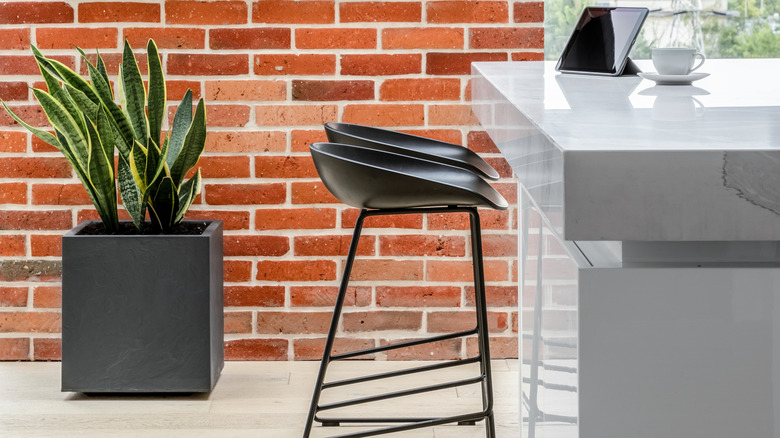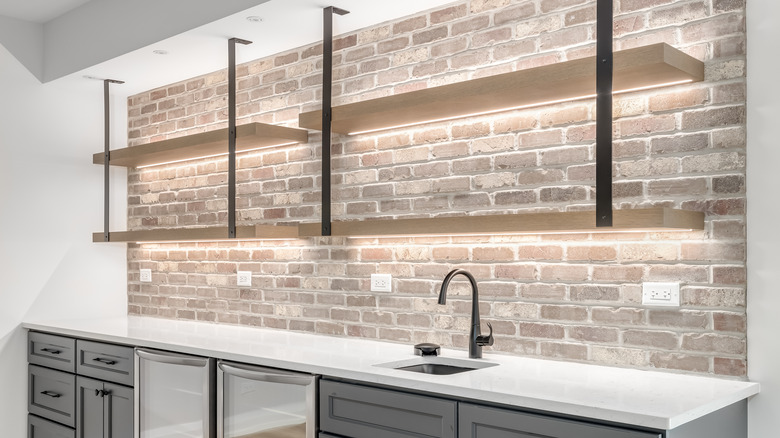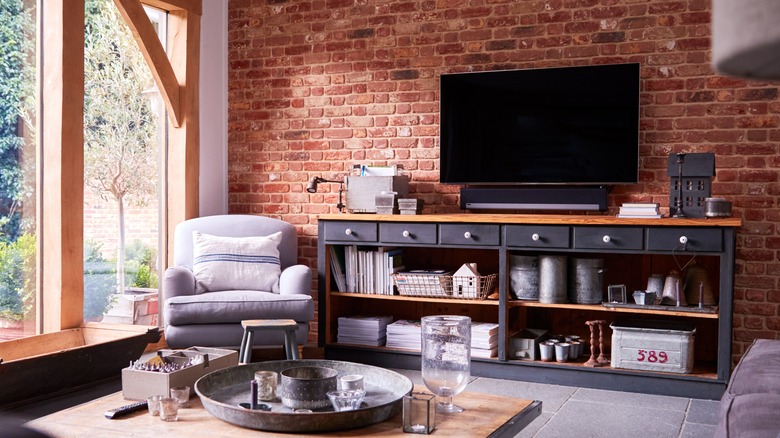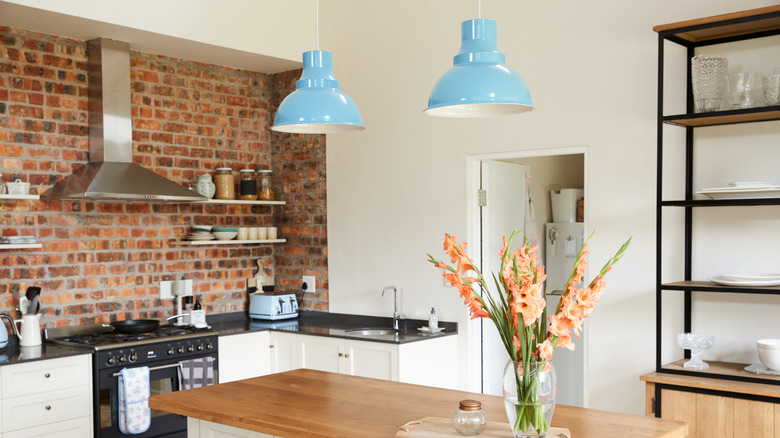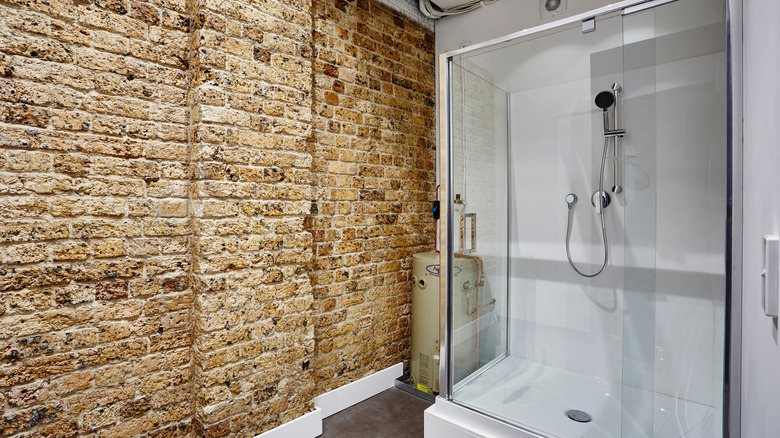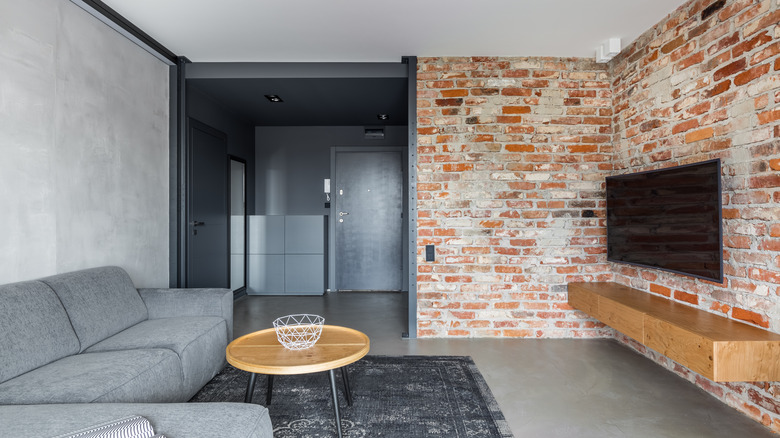5 Things To Know Before Exposing Hidden Brick
We may receive a commission on purchases made from links.
Exposed bricks is a design trend that is quite popular, especially among homeowners who want to introduce an industrial feel into their home. What's more, Fontan Architecture details that exposed bricks add character and warmth, not to mention that they can also serve as an accent wall for any room in your home. With that in mind, it is normal for anyone craving the unfinished interior look to consider demolishing the plaster to expose the hidden bricks underneath.
While this may seem like an excellent idea initially, there is always more than meets the eye when it comes to exposing the bricks in the wall. When done right, the exposed brick will delight the eyes. However, it is also necessary to mention some issues that are not often discussed. So before putting your handyman skills to the test and tearing down the plaster to expose the bricks, here are some things you should consider.
1. Remember brick is porous
Before swinging the hammer and knocking off the plaster, remember that brick and mortar are porous and will most likely absorb moisture when humidity is high. Preventing the exposed bricks from absorbing moisture is often a problem that is not emphasized well enough. Exposing bricks to your interior wall doesn't stop at stripping down the plaster; you need to put extra measures to prevent the walls from absorbing moisture and getting damp. Having damp walls is a recipe for disaster since moisture is the perfect breeding ground for molds which have long been associated with causing allergic reactions, via the United States Environmental Protection Agency.
One way of ensuring the bricks don't absorb moisture is by applying a sealant to the interior surface of the wall. Sealants are made to penetrate deep into the motor and bricks blocking the water pathways. Fortunately, sealants are available in multiple finishes, where matte and glossy are the main types. So when shopping around for this adhesive, be sure to pick the one that is in line with the interior design ideas that you have in mind.
2. You don't know the conditions of the bricks
Right from the jump, you should be aware that tearing down the smooth plaster from your walls is always a gamble because you never know what awaits behind. While you might expect to find bricks in pristine condition, the bricks might be worn out, leaving you with an ugly scene. This is particularly true for older houses! Unfortunately, you will only find out when you have already done the damage, and there is no way of going back. According to House Tipster, the bricks used in the interior walls are often flawed and not the best quality for most older homes. With this in mind, it makes sense why most houses use smooth plaster for the interior wall finish.
While exposing hidden bricks might not be ideal for older homes, you should consider alternative means of recreating the same interior finish. One good option is using a 3D wallpaper to give an almost realistic brick appearance. Another option worth exploring is using brick panels for your interior walls. They are available in different sizes and can also be painted in any color of your choice. Again, tearing down the wall plaster for older homes is a gamble; you don't want to go all the way only to find the bricks in terrible shape.
3. Think about dust
The porous nature of bricks and mortar causes more problems than water absorption, which makes bricks susceptible to changes in temperatures during the other months of the year. The expansion and contraction of the brick and mortar will cause the wall to become brittle and crumble, causing unnecessary dirt and dust in your home. You should also know that rough surfaces are usually a dirt and dust magnet; therefore, you will need to keep your walls clean frequently.
Usually, an exposed brick wall poses some challenges when it comes to cleaning. You might need special cleaning supplies and some elbow grease to keep the brick walls clean. Because exposed bricks easily crumble, you should apply a coat of dust-proof sealant to the wall. Floorseal mentions that it is necessary to use a dust-proof sealant to bind porous surfaces of the brick to prevent dust. Remember, if the surface isn't sealed, the brick can absorb substances in the air, causing staining.
4. Exposed wiring could pose a danger
Before going to full destruction mode, you should know that plaster not only hides unsightly bricks but also conveniently conceals electrical wiring from plain sight. Exposing the hidden bricks leaves you with the view of random electrical wires and hanging outlets that might not be what you had in mind in the first place. A brick exterior is abrasive; therefore, wires hanging on the surface will likely get damaged over time. Also, exposed wiring can easily cause a fire hazard if a sharp object cuts through the insulation, removing the layer of protection and causing a short.
In this regard, you should implement cable management for aesthetics and avoid risking the lives of whoever is living in that house. House fires are a significant concern killing up to 2,500 people annually in the U.S., mentions the National Fire Protection Association (NFPA). For this task, you should call an electrician to redirect and organize the electrical wires through plastic or metallic piping on the wall you choose to expose. Calling an electrician will increase the cost of your renovation, and if the whole design idea is to achieve an industrial look, piping would appear right at home.
5. Energy efficiency in your home
Regardless of the condition of the bricks on your wall, the fact is that a brick wall is one of the most inefficient energy structures in a home. Covering bricks with drywall or plaster does an excellent job of providing extra insulation to the brick walls. ScienceLine directly links poor insulation as the major cause of heat loss in buildings accounting for up to 70% of total energy loss.
But it is important to mention that exposing a single wall in your house will not likely cause any significant increase in your monthly energy bills. However, exposing multiple walls will definitely reduce your home's energy efficiency and could cause the energy bill to spike. It gets worse if the exterior wall of your house is also exposed. In such scenarios, it is better not to expose the interior walls owing to the energy inefficiency associated with brick walls.
